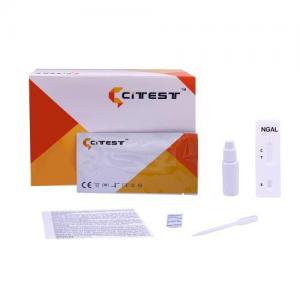

Add to Cart
Neutrophil gelatinase-associated lipocalin(NGAL) Rapid Test Cassette One Step Rapid Test
| Principle | Chromatographic Immunoassay |
| Format | Cassette |
| Specimen | WB/S/P/U |
| Certificate | CE |
| Reading Time | 10 minutes |
| Pack | 10 T |
| Storage Temperature | 2-30°C |
| Shelf Life | 2 Years |
| Sensitivity | 95.70% |
| Specificity | 97.60% |
| Accuracy | 96.40% |
| Cut-Off | 150-400 ng/Ml |
A rapid test for the qualitative detection of Methylphenidate (Ritalin) CE certified
Applications:
NGAL is a small molecular protein expressed in neutrophils and epithelial cells of some tissues and organs including renal tubules. The expression of NGAL in the kidney is significantly increased due to different reasons of renal injury and released into blood. NGAL levels can increase within 2 hours of injury, so the detection of NGAL in blood can be used to monitor patients with early renal injury.
Description:
As a biomarker of early renal function injury, NGAL is not only
present in neutrophils, but also occurs in specific epithelial
cells, such as during ischemic and toxic renal injury. NGAL in
tubular epithelial cells is significantly increased, and within the
first two hours, blood levels of
NGAL are significantly increased, so NGAL can assist in the
diagnosis of early acute renal injury.
High NGAL levels usually appear in the following situation: the
cardiovascular surgery patients, terminally ill people, purulent
blood or hemorrhagic shock, renal transplantation, the reaction of
intravenous X-ray contrast agents and reflect the renal toxicity of
treatment, more than 50% of the patients will appear a certain
degree of acute renal failure. Usually the late stages of a major
illness lead to a significant increase in mortality.
How to use?
Allow test cassette, specimen, and/or controls to equilibrate to room temperature (15-30°C) prior to testing.
1. Fresh serum, plasma,whole blood and urine samples need not be
pre-processed. Samples frozen or stored at 2~8℃ should be balanced
to room temperature before testing.
2. Sample dilution:
For serum/plasma specimen:
Hold the dropper (5μL) vertically, draw the serum/plasma specimen
and add 1 full drop of serum or plasma (approximately 10 μL) to the plastic tube with
buffer, oscillate and mix them thoroughly. You can also use a
pipette to transfer the specimen.
For whloe blood specimen:
Use a pipette: To transfer 2 μL of whole blood to the plastic tube
with buffer, oscillate and mix them thoroughly.
For urine specimen:
Use a pipette: To transfer 2μL of urine to the plastic tube with
buffer, oscillate and mix them thoroughly.
3. Remove the test cassette from the foil pouch.
4.Testing procedure: Hold another dropper vertically and transfer 4 drops of diluted sample (approximately 100 μL) and add them into sample well (S) and start
the timer. See illustration below.
5. Wait for the colored line(s) to appear. Read results at 10 minutes by comparing the T line intensity with
provided color card. Do not interpret the result after 15 minutes.
INTERPRETATION OF RESULTS
(Please refer to the illustration and compare the T line intensity
with “NGAL Color card”
Normal: Two colored lines appear, one line should be always in the control region (C) and faint colored line or no line appears in the test region (T). The line intensity in region (T) is lighter than the 150 ng/mL line depicted on the Color card.
Abnormal, possible kidney-related diseases: Two colored lines appear. One is in the control region (C) and
another should be in the test region (T). The line intensity in the
test region (T) is darker than the150 ng/mL line depicted on the
color card provided with the kit and lighter than 400 ng/mL line
depicted on color card provided with the kit.
Acute renal failure: Two distinct colored lines appear. One is in the control region
(C) and another should be in the test region (T). The line
intensity in the test region (T) is equal to or darker than 400
ng/mL line depicted on color card provided with the kit.
Note: Always compare the T line intensity with “NGAL Color card”
and interpret results accordingly.
INVALID: Control line fails to appear. Insufficient specimen volume or
incorrect procedural techniques are the most likely reasons for
control line failure. Review the procedure and repeat the test with
a new test. If the problem persists, discontinue using the test kit
immediately and contact your local distributor.
Order Information
| Cat. No. | Product | Specimen | Pack |
| CNGL-402 | Neutrophil gelatinase-associated lipocalin(NGAL)Rapid Test | WB/S/P/U | 10T |
